SOMERVILLE — Ginger Chen scans the terrain, a sharp knife at the ready. A wide smile spreads across her face as she spots something. She bends down, pokes the knife into the dirt, and wiggles loose a straggly plant.
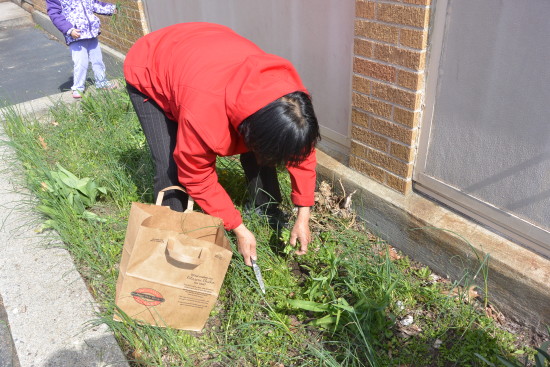
This is no ordinary, unwelcome weed. At the edge of this playground in an abandoned garden, Chen has struck gold — green, actually.
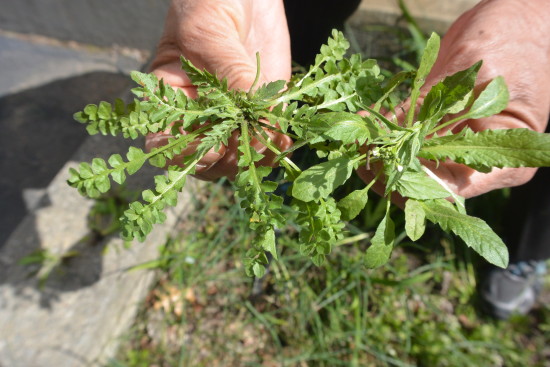
The Chinese grandmother is foraging for qi cai (pronounced chee-tsai, or jee-tsai in northern China), also known as Shepherd’s Purse, a member of the mustard family. All but the very tip of the root is edible. Spokes of multi-pointed leaves emanate from the root, and they have a clean grassy smell, celery-like taste, and tender crunch. Later, Chen will blanch and chop the greens, mix them with ground pork and aromatics, and use this as a filling for dumplings.
Shepherd’s Purse (Capsella bursa-pastoris in Latin) is popular among many Asian and Western cultures. Japanese cooks, who know it as nazuna, use it in a seven-greens rice porridge; in Korea, naengi, as it’s known, is part of highly seasoned salads. In Europe and this country, Shepherd’s Purse is a tisane and extract for a variety of ailments.
Chen, 67, whose Chinese name is Mei Zhen, arrived in Somerville 10 months ago from her native Chongming Island, located at the mouth of the Yangtze River near Shanghai. She came to help her daughter, Rachel Huang, and son-in-law, Jason Faulkner, when Rachel gave birth to Clio, now 8 months. She did the same when Stella, 2½, her first granddaughter, was born. Chen practiced all the Chinese customs for new moms: Rachel had to rest, eat gelatinous soups made with fish and pig’s feet, and never touch cold water.
The grandma speaks no English, so Huang and Faulkner translate for a visitor. In the bright and spacious second-floor kitchen of their home, Chen fills the sink with water and thoroughly washes and drains the greens, then soaks them.

She carefully slices just a bit from the root, leaving the green bundle intact, then lowers them into a pot of boiling water, and blanches them only enough to wilt them, but retain their brilliant color. Then she drains and refreshes them under cold water. The process is laborious. Now she scoops up a handful, squeezes out all the liquid, and sets the clumps on a cutting board. Huang, who is acting as kitchen assistant, chops them with precision.
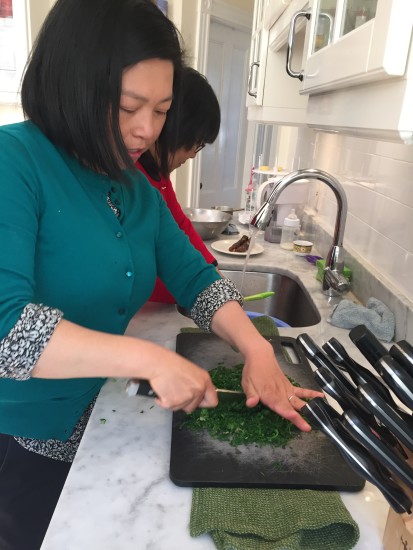
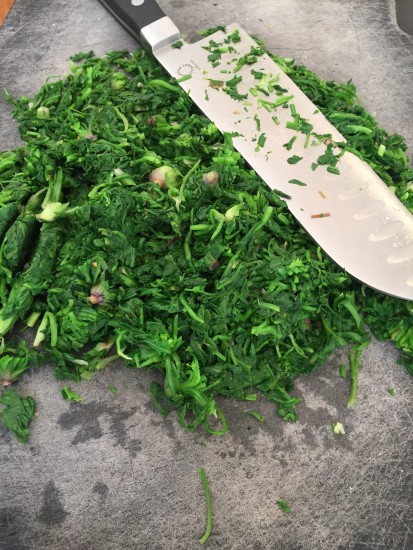
Huang, 35, whose Chinese name is Yanping, met Faulkner, 32, through friends, when both were living in China in 2004. “We fell in love, traveled around China, and got married in 2006,” says Faulkner, who had gone to Shanghai on a study abroad program while at Bunker Hill Community College. “I liked it there so much, I dropped out of college, stayed, and taught English,” he says. He also learned to speak fluent Mandarin. The couple returned to Somerville, where Faulkner was raised, and bought a condo almost next-door to where he grew up.
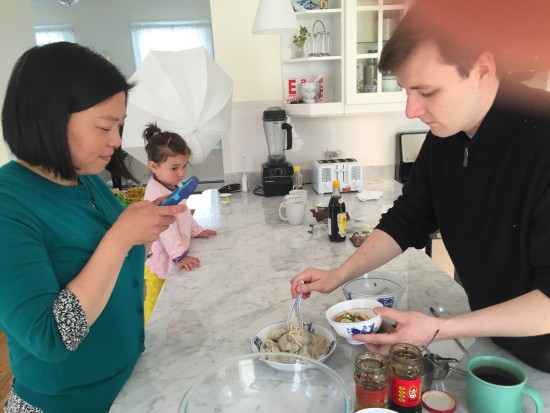
While his mother-in-law is visiting, there are no language problems. Mother and daughter converse in Chongming dialect, but both speak Mandarin with Faulkner. He is delighted by Chen’s foraging adventures. In that sense, she is no different from other Chinese women. Cookbook author Helen Chen (no relation), daughter of Cambridge restaurateur Joyce Chen, tells a similar tale. “My mother used to harvest Shepherd’s Purse in front of the Belmont Post Office before they covered their lawn with cement,” Helen Chen writes in an e-mail. “She used to fill wontons and serve them in soup.”
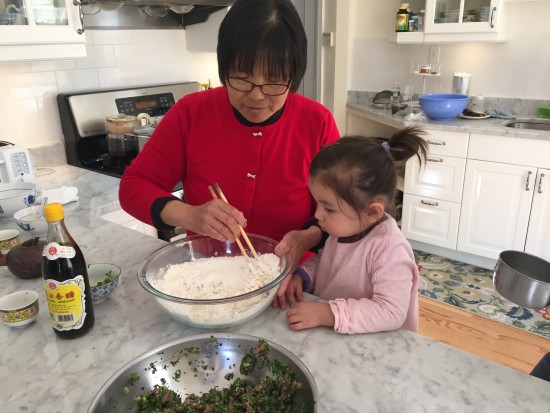
Ginger Chen is also making wontons, or dumplings, with her Shepherd’s Purse, which she combines with ground pork, soy sauce, salt, scallions, and fresh ginger. “It is important that the ratio of meat to greens is 50-50,” says Chen.
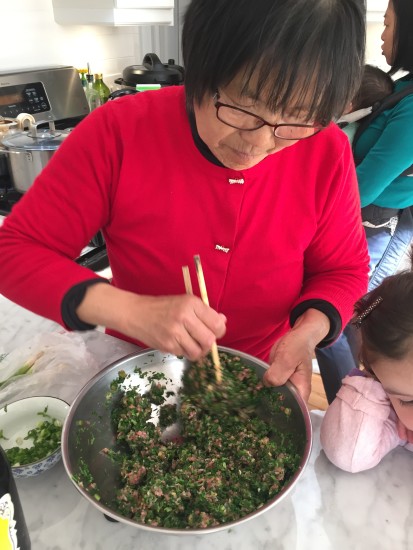
In China, she explains, she buys dumpling wrappers, but in Somerville she makes her own. She flours the marble counter and kneads the flour and water dough.
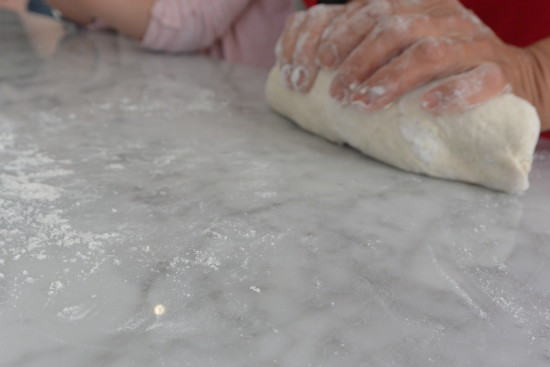
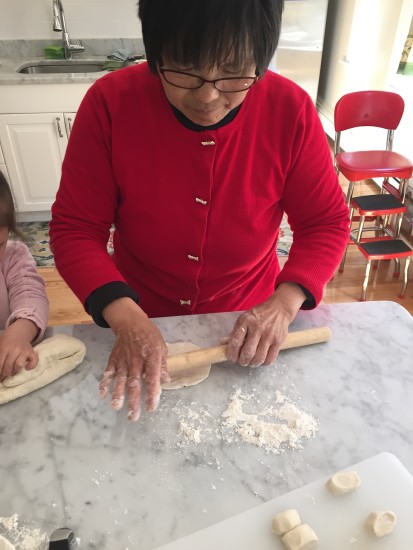
Stella, perched on a stool, helps her buwa (grandma in Chongming). Chen pinches off a plump piece and now Stella has her own real Play Doh, which she gleefully pats.
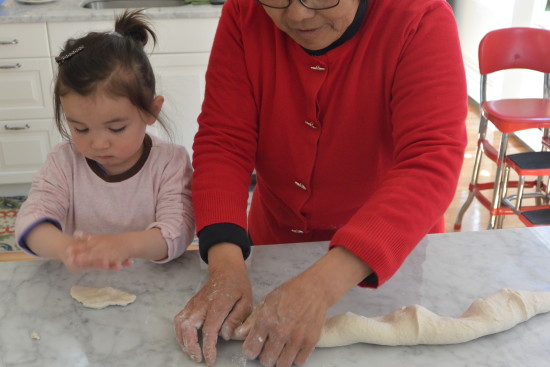
Using chopsticks, Chen picks up a small portion of the ground pork mixture and places it in the center of a soft wrapper in her palm. She sets down the chopsticks, and uses her other hand to fold the dough over the meat into a half moon, and pinch the edges together.
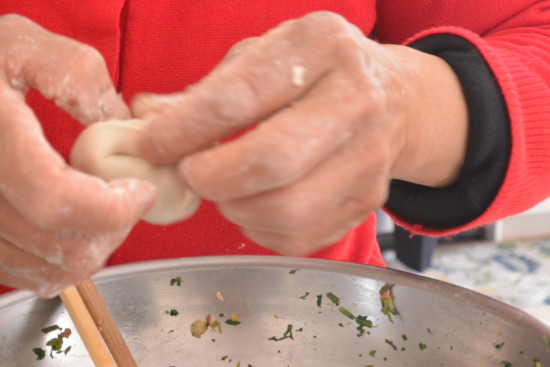
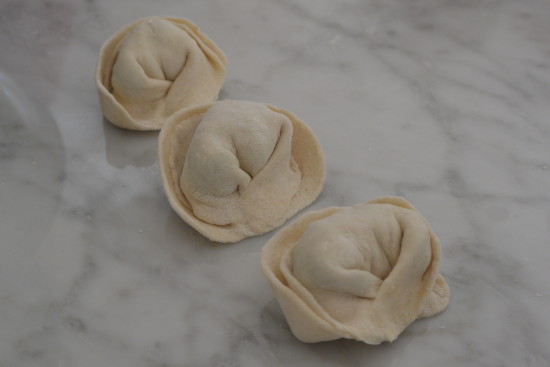
She sets the chubby packet down and, with precision and speed, makes her way through the remaining pieces of dough.
She boils the dumplings for a few minutes, transfers them to bowls filled with sesame oil, salt, and scallions, and ladles some of the starchy cooking liquid over them.
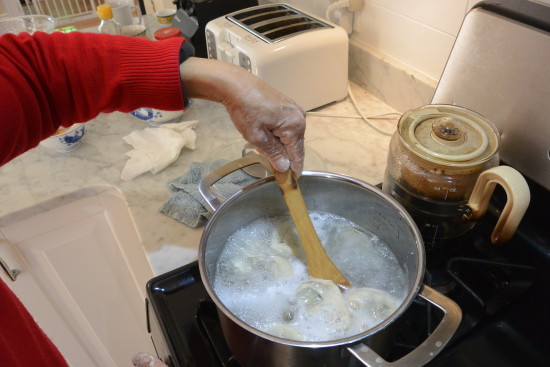
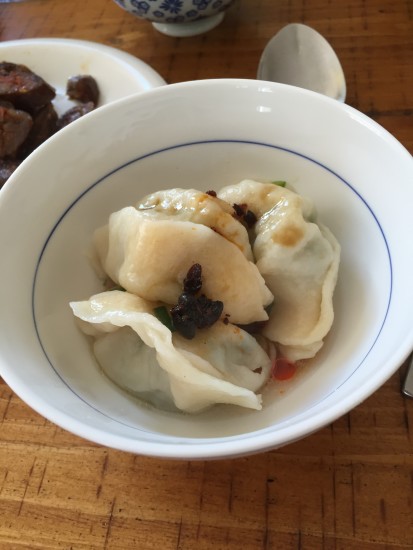
The velvety dough and clean green taste of the filling marries well with a black-vinegar and spicy black-bean dipping sauce. Chen doesn’t consider this an appetizer, like it might be in a Chinese restaurant. “I could eat 10 at one time,” she says.
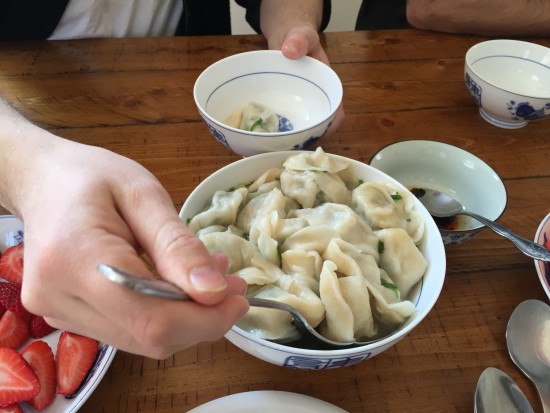
Shepherd’s Purse is almost past its season. Chen stops foraging when the greens produce little white flowers and seeds and they turn bitter. The shoots are also available frozen, but they lack the grassy flavor and bite of the fresh.

Chen likes to take Stella on her culinary expeditions so they can dig together. With her experienced hands, she places the freshly dug greens, dirt clinging to the roots, into her granddaughter’s small palm, in an effort to pass on her knowledge and love.
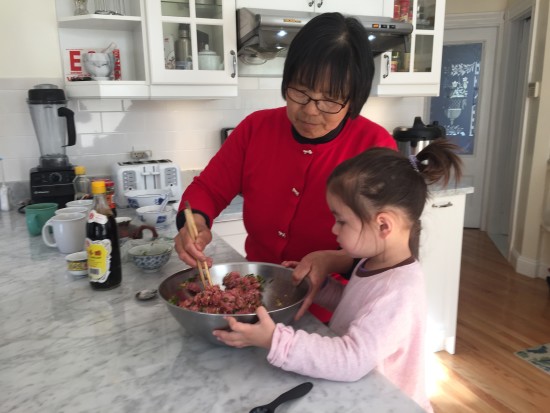
Some day Stella will make dumplings for her buwa.

Makes about 42 or enough for 4 as a main course
Ginger Chen makes her Shanghai-style dumplings with Shepherd’s Purse, available frozen in Chinese supermarkets in 16-ounce bags; look for Hunsty (WellLuck) brand, with a picture of the vegetable on the package. Here, the dumplings are made with ground pork and frozen spinach.
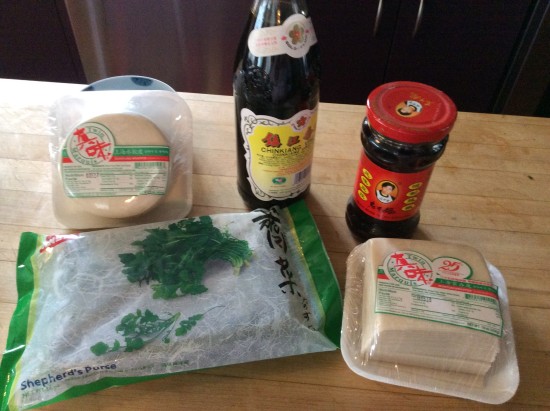
Buy round or square dumpling wrappers (Twin Marquis brand Shanghai-style wrappers, sold in Asian supermarkets, come 40 to 50 to a package). After cooking, make a dipping sauce to accompany them by mixing Lao Gan Ma spicy black bean chile sauce (red label with photo of a Chinese woman ) and Chinkiang black vinegar.
| Flour (for sprinkling) |
| 2 |
packages (10 ounces each)
frozen spinach, thawed |
| ¾ |
pound ground pork |
| 1 |
piece (2 inches) fresh ginger, finely chopped |
| 3½ |
teaspoons kosher or sea salt |
| 6 |
scallions, finely chopped |
| 2½ |
tablespoons soy sauce |
| 1 |
package (6 ounces) eggless round or square dumpling or wonton wrappers (about
40 to 50) |
| 2 |
teaspoons sesame oil |
| 4 |
teaspoons Lao Gan Ma black bean sauce |
| ¼ |
cup Chinkiang vinegar (black vinegar) |
1. Sprinkle a rimmed baking sheet and your work surface with flour. Have on hand a small bowl of water.
2. Place thawed spinach in a colander. Take a handful of spinach and squeeze the liquid from the spinach until no more liquid drips from the greens. Place the spinach on a chopping board. Repeat until all the spinach has been squeezed dry. Finely chop the spinach and transfer to a bowl.
3. Add the pork, ginger, 1½ teaspoons of salt, ½ of the chopped scallions, and soy sauce. With your hands, mix until thoroughly combined.
4. Set several dumpling or wonton wrappers on the work surface. Cover the remaining wrappers with a damp paper towel. Place about 2 teaspoons of the filling in the middle of the wrapper. With your finger, wet the edge halfway around. Fold the wrapper in half to make a half-moon shape. Seal the dumpling all around, pressing the edges together.
5. Set a dumpling in front of you with the rounded side facing away from you. With a finger, dot the right end of the half moon with water. Bring the right end down vertically as you bring the left end down. Overlap the left edge on top of the wet spot and press shut. Set on the floured baking sheet. Continue until all filling is used.
6. In each of 4 soup bowls, place ½ teaspoon salt, and ½ teaspoon sesame oil. Divide the remaining scallions among them.
7. Fill a large pot with water. Bring to a boil. Add half the dumplings and return to a boil. Lower the heat to medium and cook for 4 minutes or until a dumpling you cut in half has no pink in the center of the meat.
8. Meanwhile in each of 4 small bowls, place 1 teaspoon black bean sauce and 1 tablespoon vinegar.
9. With a slotted spoon, remove the dumplings from the water and divide among the 4 soup bowls. Add about ½ cup of the cooking liquid to each one. Serve with the dipping sauce, spoons, and chopsticks.
10. Return the cooking water to a boil and cook the remaining dumplings in the same way.
Adapted from Ginger Chen

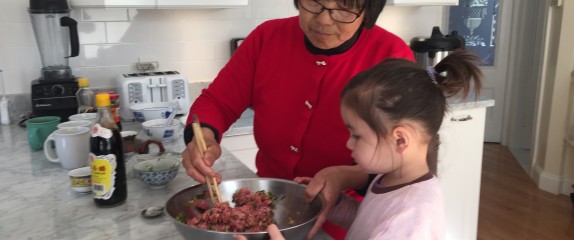


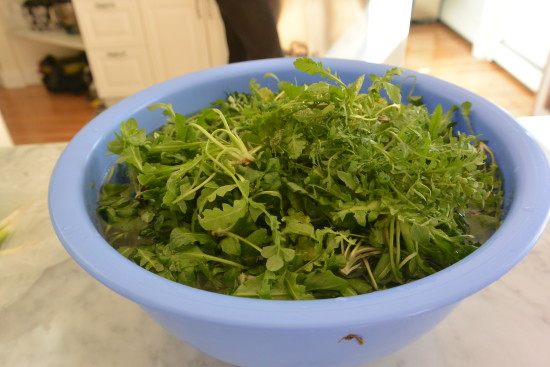

















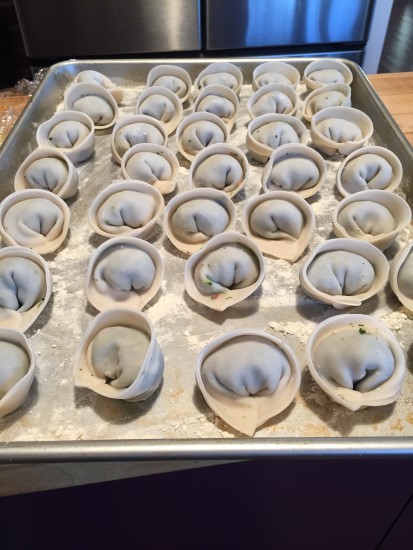











 Debra Samuels, bestselling author, food writer and cooking instructor,
Debra Samuels, bestselling author, food writer and cooking instructor,